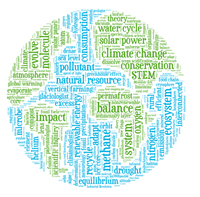Going Green or Clean?
By: Erin Twamley
PDF version of this blog available here.

It is National Clean Energy Week (September 20-24, 2021)! This week hosted by the Business Council for Sustainable Energy is about celebrating the energy transition. Clean energy technology and jobs are building a more sustainable economy and driving a commitment towards an emissions-free future.
During this week, articles and conversations using “clean energy”, “renewable energy” or phrases like “sustainable” or “going green” may be commonplace. These terms are often used when talking about the energy transition or climate change, but many of us confuse and do not use the terms correctly. These terms do have important differences!
|
What is the difference between clean vs. green and renewable energy?
The terms we use matter, not just because of the science behind them, but also because the understanding informs decisions. The differences are important in understanding the energy sources that do and could power our world. Addressing climate change will take global and collective actions. How one country moves in the energy transition will impact all of us. Emissions know no boundaries! It will take a mix of sustainable resources to power us into the future.
Going Green
“Going green” is like a campaign, a movement, or a call to action for individuals, schools or even cities around the world. Going green means to create or use processes and actions that reduce emissions. These actions whether individual or on a larger scale often are around efforts such as recycling, community gardens, and planting trees. The movement of going green is often used as a way to globally connect people with local actions. Note that this explanation is different from green energy!
Defining Clean
While all the going green actions are helpful, globally we are using fossil fuels to power our planet. While fossil fuels have provided a cheap energy source and industrialized our civilization, the burning of these fossil fuels releases emissions and contaminants to the atmosphere. This has an impact on our planet, the environment, and human health.
Globally, we are all taking part in the energy transition, the movement away from the reliance on fossil fuels. We are looking for clean energy sources that release small to zero amounts of radiation, carbon dioxide, and chemical contaminants into the atmosphere and soil. Nuclear is a good example of a clean energy source. Although nuclear does not produce emissions, (what you see is actually steam rising from the cooling towers!) it does produce a very harmful waste. Figuring out how to store this waste safely is important for protecting humans and our planet.
To reduce emissions, traditional oil and natural gas companies have invested millions into research and technology to put carbon dioxide back into the Earth. This is known as carbon capture and sequestration. Some scientists believe this will play an important role in addressing climate change as we transition to more renewable sources.
Defining Renewable Energy
Biomass, geothermal, hydropower, solar, and wind are renewable energy sources. Renewable energy is abundant – each day the sun shines and the wind blows. Great strides continue to be made to use renewable sources to power our planet. Technology is constantly evolving to address their challenges, such as cost and energy storage.
Learn about each energy source with NEED’s Energy Infobooks, which include an introduction to energy, information on major sources of energy, new technologies, energy conservation, electricity, and climate change. Updated annually and available at the primary, elementary, intermediate, and secondary level. Free PDF download or e-publication! Be sure to check out the companion Energy Infobook Activities guides, too!
It will take local action and bold policy to drive the energy transition and stop climate change. It will take a mix of clean and renewable energy sources coupled with local green action to make our planet healthier, greener, and cleaner.
BIO:
Erin Twamley is an educator (M.Ed.) and award-winning children’s book author. Twamley is the lead author of the multicultural children’s book series, Everyday Superheroes. This series shares the stories, careers, and superpowers of women in STEM. She is currently writing the 2nd book, featuring Women in Energy (WiseInk, March 2022)! She loves to travel, read, and has lived on three continents.
Visit the NEED Shop to see her books or learn more about her at www.erintwamley.com
